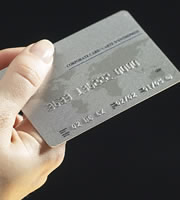Credit cards show stability in a changing economy

June 15, 2014
Current averages:
- Average consumer credit card rate, overall market: 17.12 percent
- Average consumer non-rewards credit card rate: 15.48 percent
- Average consumer rewards credit card rate: 17.83 percent
- Average student credit card rate: 17.56 percent
- Average business non-rewards credit card rate: 14.99 percent
- Average business rewards credit card rate: 15.31 percent
The U.S. bank prime rate was unchanged in the first half of June, at 3.25 percent.
There were no changes in any of the credit card offers tracked by this survey. This lack of action in rates comes with the U.S. economy seemingly poised at a crossroads — yet again.
Technically, the U.S. economy is approaching five years since the end of the Great Recession, which is about the average length for economic expansions since World War II. However, this expansion has felt like a series of turning points, with the economy seeming to show strength one month and then teetering back on the edge of recession then next.
With less than half the year gone, 2014 so far has been a perfect example of the stop-and-start economy. In the first quarter of the the year, the economy actually contracted. A brief contraction is not the same as a recession, but a continued contraction would eventually represent a recession. According to the latest estimate from the Bureau of Economic Analysis, U.S. GDP shrunk at an inflation-adjusted rate of 1.0 percent in the first quarter.
In contrast, as of May the job market had posted four consecutive months of employment growth in excess of 200,000. This is evidence that the economy is gaining strength, and that more income is coming back on line. This suggests the economy has shaken off the doldrums of the first quarter, and has started growing again.
Most likely, the best outcome for credit card rates would be moderate but steady growth. This would mean fewer of the slowdowns which raise credit concerns, but also not a rapid enough expansion to drive inflation higher.
So far, credit card companies have shown restraint in the face of the economy’s ups and downs — while those turning points for the economy have been frequent, changes in credit card rates have been relatively few. A more stable economic environment would help this continue this consistency in credit card rates, which in turn would make it easier for consumers to stay informed about their current rates and the available alternatives.
Consumer credit card rates
Rates on both consumer rewards and non-rewards credit cards were unchanged over the first two weeks of June. A relatively stable rate environment is conducive to comparison shopping, since consumers can research and compare rates without fear of frequent changes. This exercise can be well worth while — for example, at the lowest rate tier of consumer rewards credit cards, there is a difference of more than 10 percentage points between the most and least expensive rates.
Student credit card rates
Student credit card rates were unchanged for the seventh consecutive time in this semi-monthly survey.
Business credit card rates
Business non-rewards and rewards credit cards were both unchanged in early June. With the spread between the averages of these two categories remaining very low at 32 basis points, this may be a good time to consider the benefits of a rewards program. The optimal strategy is to use rewards for the organization’s benefit or for employee morale purposes, while paying off monthly balances in full to avoid paying any extra interest for those rewards.
Excellent credit vs. average credit
The lowest rate tier of consumer credit cards is available to customers with excellent credit histories. The difference between the average of this rate tier and the overall average for consumer credit cards is 4.01 percent, which represents one of the potential benefits of maintaining a spotless credit record.
In total, IndexCreditCards.com surveys information from nearly 50 different credit cards, and includes multiple credit-rating tiers from many of those cards. Examples of offers surveyed include American Express, Capital One, Chase, Citi, Discover, and other MasterCard and Visa branded cards. The information compiled not only demonstrates trends in credit card rates over time, but also indicates the different values credit card companies put on different target markets (consumer, business, etc.), as evidenced by the differences between rates for those markets.
Disclaimer:The information in this article is believed to be accurate as of the date it was written. Please keep in mind that credit card offers change frequently. Therefore, we cannot guarantee the accuracy of the information in this article. Reasonable efforts are made to maintain accurate information. See the online credit card application for full terms and conditions on offers and rewards. Please verify all terms and conditions of any credit card prior to applying.
This content is not provided by any company mentioned in this article. Any opinions, analyses, reviews or recommendations expressed here are those of the author’s alone, and have not been reviewed, approved or otherwise endorsed by any such company. CardRatings.com does not review every company or every offer available on the market.
Published